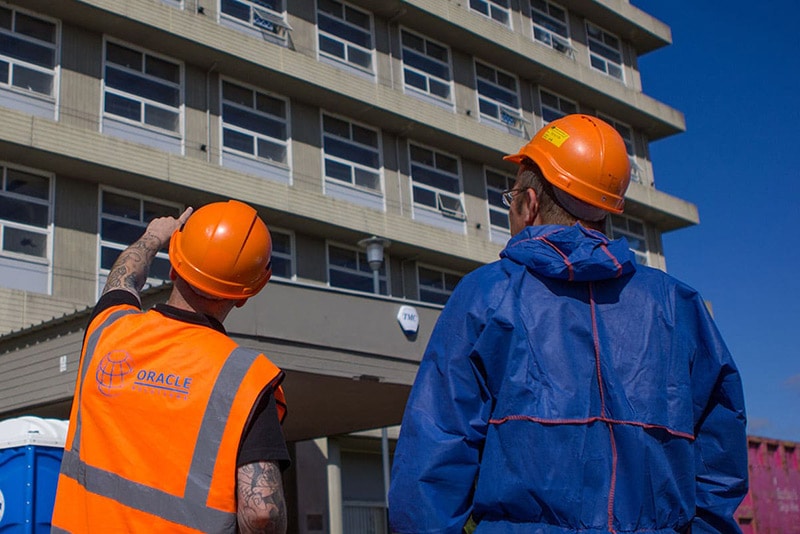How many types of asbestos training are there?
According to the Health and Safety Executive (HSE), which oversees asbestos regulations and compliance, “Every employer must make sure that anyone who is liable to disturb asbestos during their normal work, or who supervises those employees, gets the correct level of information, instruction and training so that they can work safely and competently without risk to themselves or others.”
There are several kinds of asbestos training courses. They range from asbestos awareness and supervisory training to guidance for workers who will deal directly with different types of asbestos. The main categories of asbestos training are awareness, non-licensable work, and licensable work.
Basic asbestos awareness training
Asbestos awareness training isn’t for those who will work directly with asbestos. Instead, it’s for supervisors and employees who need to know how to avoid work that could disturb asbestos on the premises.
Topics covered in asbestos awareness training include the following:
- The negative health effects of asbestos exposure
- The types of asbestos commonly found in buildings
- General asbestos emergency procedures
- Tactics for avoiding asbestos exposure
Again, this type of training is not preparation to work with asbestos or asbestos-containing materials (ACMs).
Workers who take asbestos awareness training won’t be working directly with asbestos and don’t need in-depth guidance. In this case, UKATA-certified online training may be enough. Asbestos awareness training typically takes approximately four hours to complete.
Refreshing asbestos awareness training
There isn’t a legal rule to update asbestos awareness training. But, it’s a good practice to have employees take a refresher class every 12 months. This keeps everyone up to date so they can stay safe.
An asbestos awareness refresher can be delivered via e-learning or along with other safety updates. This is an alternative to having employees take another full training course.
It’s also wise to determine which employees may need more training based on their level of competence. For example, a worker who is often near ACMs who has forgotten much of their training may need to take the full course again.
Note that workers who received more advanced training, which we’ll discuss next, don’t need to take asbestos awareness refresher training.
Non-licensed asbestos work training
Workers with jobs that require them to disturb ACMs will need more advanced training than asbestos awareness. That includes non-licensable work and Notifiable Non-licensed Work (NNLW) training.
Non-licensable work and NNLW may include:
- Cleaning or repairing asbestos cement
- Drilling holes into ACMs for analysis and sampling
- Laying cables near undamaged ACMs
- Removing floor tiles that contain asbestos
Training for non-licensable asbestos work includes:
- Assessing the risk of ACMs in the building
- Control methods and protective equipment when working with asbestos
- Properly handling asbestos waste
- Legal requirements when working with asbestos
- Types of asbestos work that are notifiable
Non-licensable asbestos training typically takes six to nine learning hours. The duration depends on whether the individual has already taken asbestos awareness training or not.
Also, check out our article with 7 things to consider after completing your non-licensed asbestos training.
Licensed asbestos work training
People who have to work with asbestos beyond handling low-risk materials should take licensed asbestos work training. According to the HSE, “Only competent workers and managers, provided with suitable information instruction and training and using appropriate respiratory and other protective equipment, may undertake licensed asbestos work.”
Examples of licensable asbestos work include:
- Cleaning up a large amount of ACM dust
- Removing sprayed asbestos coatings
- Work that could disturb asbestos pipe lagging
- Work involving loose-fill asbestos insulation
According to UKATA, training for licensable asbestos work includes information about:
- Setting up, maintaining, and dismantling a work site
- Controlled asbestos-removal techniques
- Personal and respiratory protective equipment
- Asbestos transit and decontamination procedures
- Air testing after asbestos work is finished
Licensable asbestos training takes at least six learning hours. There are different categories of licensable asbestos training depending on the worker’s role. Each category has guidelines for how much training is needed.
Refreshing non-licensable and licensable asbestos work training
According to the HSE, “Refreshing information instruction and training for licensable and non-licensable work should be appropriate to the work each worker is doing.”
For example, workers performing extensive asbestos work may need more training in the classroom or on the job site. On the other hand, workers who carry out minimal, low-risk asbestos work may only need minimal refresher training to cover the main principles.
Refresher training for non-licensable and licensable asbestos work should be held every year or even more often if the following is true:
- Different equipment is used to control asbestos exposure
- There’s a change in the type of work or work methods
- Workers show gaps in competency
The most important aspects of asbestos training to cover during refresher courses are controlled removal, decontamination, and protective equipment.
Duty to manage asbestos training
The individual who manages a non-domestic building and protects the people who work on those premises also has a duty to manage asbestos. Duty to manage asbestos training gives the person responsible — the dutyholder — working knowledge of the Control of Asbestos Regulations 2012 (CAR 2012).
Duty to manage asbestos training will cover topics like:
- Determining where ACMs are in the building
- Conducting asbestos surveys and risk assessments
- Creating an asbestos management plan
- Ongoing monitoring of ACMs in case they become damaged
- Complying with the legal responsibilities of asbestos management
Duty to manage asbestos training can last from three to six hours. The duration depends on whether the individual has received prior training and when prior training occurred.
Supervisory asbestos training
There isn’t asbestos training specifically for supervisors. Yet, a person in a supervisor position should at least receive asbestos awareness training. As the HSE states, any employee who could disturb asbestos or the person who supervises those employees needs the proper level of asbestos training to work competently and safely around ACMs.
A training needs analysis (TNA) can be used to determine how much training a supervisor requires. The analysis will consider the supervisor’s duties and associated hazards, as well as any training they’ve already received. From there, you can determine what type of training is necessary.
At the very least, supervisors must know how to recognise ACMs and what to do if they come across an ACM. The goal is to protect themselves and anyone else who could be affected.
Industry-specific training
While there aren’t any industry-specific asbestos training courses, asbestos training and refresher training should be relevant to the individual taking the course.
For example, electricians taking an asbestos training course will benefit most from learning about asbestos challenges with electrical installations than, say, roofing or concrete.
This is why face-to-face asbestos training is often preferred to online training. When you can directly converse with the instructor, you can let them know the areas you specialise in to receive personalised information.
We have an article that discusses in-person vs. online asbestos training to help you decide what’s best for you.
Certificates of asbestos training
According to the HSE, “There is no legal requirement for employees to hold a certificate of training before they can work with asbestos.”
However, it’s common for training providers to issue certificates that show that training was completed. (Certificates don’t prove that the individual is competent to perform an asbestos job, though.) Some workers opt to keep their certificates with their training records.
Also, some training certificates have an expiration date. Still, this doesn’t mean that a full retraining class is required after that expiration date.
The UK Asbestos Training Association (UKATA)
While the HSE doesn’t endorse any asbestos training associations, UKATA is considered a leader in the field. UKATA has high standards for members to attain and retain their asbestos training certifications. Plus, courses are aligned with CAR 2012.
As mentioned, having an asbestos training certificate is not a legal requirement in the UK. However, an employee who can present a UKATA certification shows that they’ve received high-quality training.
Wrapping up
Even with the proper training, a worker may not be entirely competent when it comes to asbestos. Proficiency is gained over time from a combination of training courses, on-the-job learning, knowledgeable instruction, and regular assessments.
Receiving proper training is a great start to ensure the worker knows enough so they won’t put themselves or others at risk when dealing with asbestos. From there, they can develop more skills and expand their expertise.
At Oracle Solutions, we offer UKATA-certified asbestos training. To book your place on one of our courses, contact the Oracle team today.

Written by Brendan Coleman
Brendan Coleman, with decades of experience in the asbestos industry, is a dedicated Quality Manager. Certified as a surveyor and analyst, he is adept in operations and quality management with a keen focus on HSE compliance. His expertise is pivotal in maintaining high safety and efficiency standards. Brendan ensures our UKAS accreditation requirements are consistently met and exceeded, upholding stringent standards in asbestos remediation. His commitment to enhancing quality and customer satisfaction makes him an essential advisor in asbestos management.


